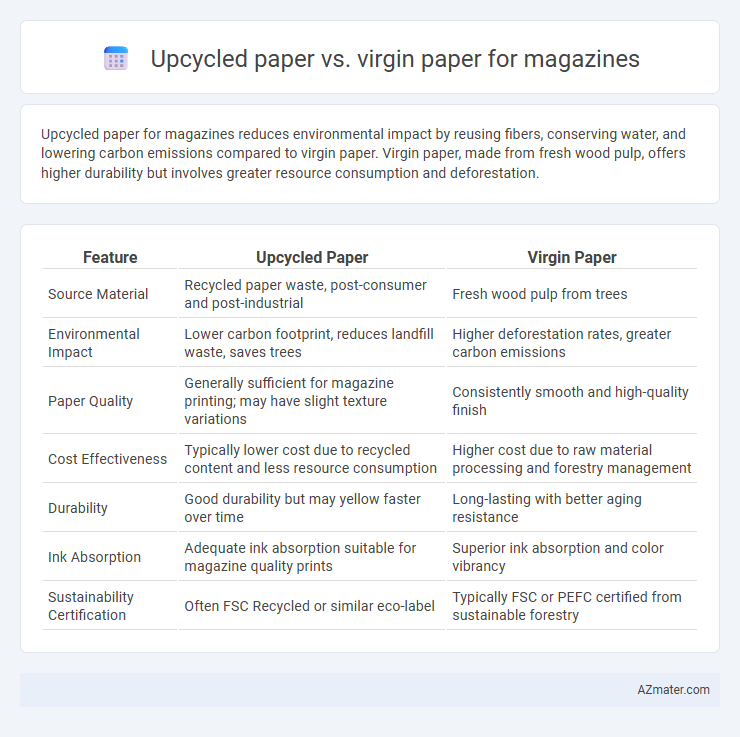Upcycled paper for magazines reduces environmental impact by reusing fibers, conserving water, and lowering carbon emissions compared to virgin paper. Virgin paper, made from fresh wood pulp, offers higher durability but involves greater resource consumption and deforestation.
Table of Comparison
| Feature | Upcycled Paper | Virgin Paper |
|---|---|---|
| Source Material | Recycled paper waste, post-consumer and post-industrial | Fresh wood pulp from trees |
| Environmental Impact | Lower carbon footprint, reduces landfill waste, saves trees | Higher deforestation rates, greater carbon emissions |
| Paper Quality | Generally sufficient for magazine printing; may have slight texture variations | Consistently smooth and high-quality finish |
| Cost Effectiveness | Typically lower cost due to recycled content and less resource consumption | Higher cost due to raw material processing and forestry management |
| Durability | Good durability but may yellow faster over time | Long-lasting with better aging resistance |
| Ink Absorption | Adequate ink absorption suitable for magazine quality prints | Superior ink absorption and color vibrancy |
| Sustainability Certification | Often FSC Recycled or similar eco-label | Typically FSC or PEFC certified from sustainable forestry |
Introduction to Upcycled and Virgin Paper
Upcycled paper is made from recycled paper materials that are repurposed to reduce waste and environmental impact, offering a sustainable alternative for magazine printing. Virgin paper, produced directly from freshly harvested wood pulp, provides superior strength and brightness, ideal for high-quality magazine visuals. Choosing between upcycled and virgin paper depends on balancing ecological benefits with print quality requirements.
Environmental Impact: Upcycled vs Virgin Paper
Upcycled paper significantly reduces environmental impact by utilizing post-consumer waste, cutting down on deforestation and energy consumption compared to virgin paper. Virgin paper production requires fresh timber and intensive water and chemical use, leading to higher carbon emissions and habitat destruction. Choosing upcycled paper for magazines supports sustainable resource management and lowers landfill waste.
Resource Consumption and Sustainability
Upcycled paper for magazines significantly reduces resource consumption by utilizing post-consumer waste, thereby lowering the demand for fresh wood pulp and minimizing deforestation. Virgin paper production requires substantial water, energy, and chemical inputs, leading to higher carbon emissions and environmental degradation. Choosing upcycled paper enhances sustainability by conserving natural resources, reducing landfill waste, and supporting a circular economy in print media.
Production Process Differences
Upcycled paper for magazines relies on reclaimed fibers from previously used paper, significantly reducing the need for virgin wood pulp and lowering energy consumption during production. Virgin paper production involves processing fresh wood fibers through mechanical or chemical pulping, resulting in higher resource use and increased environmental impact. The upcycling process also minimizes water pollution and greenhouse gas emissions compared to the traditional virgin paper manufacturing cycle.
Quality and Print Performance
Upcycled paper for magazines offers eco-friendly benefits but often has lower brightness and opacity compared to virgin paper, impacting image sharpness and color vibrancy. Virgin paper, derived from fresh wood pulp, ensures superior print quality with consistent texture and enhanced ink absorption, resulting in vivid and sharp magazine pages. Print performance on virgin paper remains more reliable, supporting high-speed presses without ink bleeding or smudging common in recycled fibers.
Cost Comparison: Upcycled vs Virgin Paper
Upcycled paper for magazines typically costs 10-20% less than virgin paper due to reduced raw material expenses and lower energy consumption in production. Virgin paper, made from fresh tree pulp, involves higher costs linked to logging, processing, and chemical treatments, which increase the overall manufacturing price. Choosing upcycled paper not only lowers printing costs but also supports sustainable practices by reducing waste and conserving natural resources.
Consumer Perception and Market Trends
Consumer perception increasingly favors upcycled paper for magazines, associating it with environmental responsibility and sustainable living. Market trends reveal a growing demand for eco-friendly publications, with brands leveraging upcycled paper to enhance green credentials and appeal to conscious readers. Virgin paper remains preferred for premium tactile quality, though innovations in upcycled paper production are narrowing this gap.
Industry Standards and Certifications
Upcycled paper for magazines aligns with industry standards such as FSC Recycled and Blue Angel certifications, ensuring it meets strict environmental and quality criteria while reducing reliance on virgin fiber. Virgin paper typically holds FSC Mixed or Pure certifications, verifying sustainable forest management but involves higher resource consumption and carbon emissions. Choosing upcycled paper supports circular economy principles and complies with increasing regulatory demands for sustainable publishing materials.
Case Studies: Magazines Using Upcycled Paper
Several leading magazines have successfully integrated upcycled paper into their print editions, demonstrating both environmental benefits and quality retention. Case studies such as *National Geographic* and *Elle* highlight significant reductions in carbon footprint and water usage compared to virgin paper, without compromising visual appeal or durability. These examples underscore the growing trend and feasibility of sustainable paper alternatives within the publishing industry.
Future Outlook for Sustainable Magazine Publishing
Upcycled paper offers a lower environmental footprint compared to virgin paper, reducing deforestation and energy consumption, making it a promising material for sustainable magazine publishing. Innovations in recycling technologies enhance the quality and durability of upcycled paper, aligning with the industry's demand for high-quality print media. As consumer awareness grows, magazine publishers adopting upcycled paper are positioned to meet sustainability goals while appealing to eco-conscious audiences.

Infographic: Upcycled paper vs Virgin paper for Magazine
 azmater.com
azmater.com